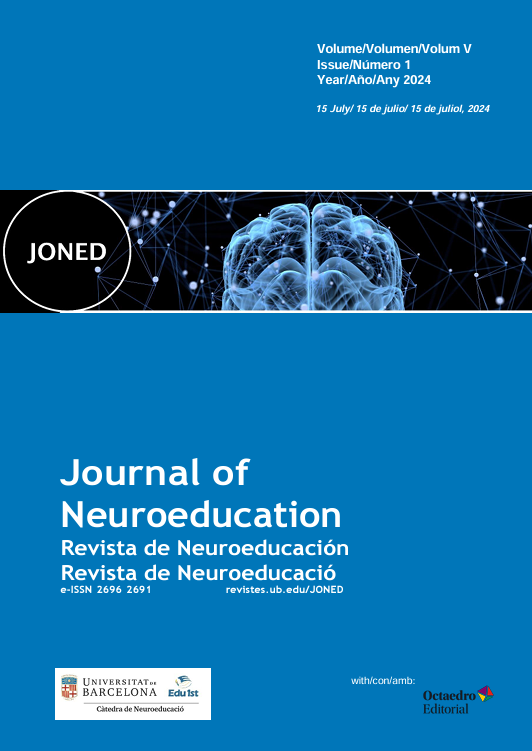Teaching – It’s a No Brainer, Right?: Using an Assessment Course to Bust Educators’ Neuromyths
DOI:
https://doi.org/10.1344/joned.v5i1.46856Keywords:
misinformation, neuromyths, survey, assessment, educationAbstract
Misinformation about the brain, known as neuromyths, is prevalent among educational practitioners and often inadvertently (mis)informs instructional strategies. In the current study, a mixed methods design was used to test how resources and instruction on neuromyths implemented within an assessment course impacted elementary education pre-service teachers’ (PSTs’) beliefs about the brain. Specifically, this study aims to address: (1) Where do PSTs learn neuromyths? (2) Does an explicit focus on “neuromyth-busting” in a required course shift PSTs’ understanding of neuroeducational science? (3) What are PSTs’ understanding of neuroeducational science and the impacts on their practice after this course? Results from a pre-/post-survey show that many of the PSTs’ neuromyth beliefs shifted by the end of the course. Through open-ended survey responses, PSTs reported that they learned neuromyths from a variety of resources and their thoughts about neuromyths are multifaceted and complex. By the end of the course, PSTs related what they learned about the brain to the importance of differentiating instruction. Findings indicate that using a mixed methods approach provides a well-rounded view of PSTs’ beliefs in neuromyths. Incorporating information about the brain in education courses may be an effective way to promote critical thought and dispel common neuromyths among PSTs.
References
Grospietsch F, Mayer J. Professionalizing pre-service biology teachers’ misconceptions about learning and the brain through conceptual change. Educ Sci. 2018;8(3):120. doi: 10.3390/educsci8030120.
Grospietsch F, Mayer J. Pre-service science teachers’ neuroscience literacy: Neuromyths and a professional understanding of learning and memory. Front Hum Neurosci. 2019;13. doi: 10.3389/fnhum.2019.00020.
Howard-Jones P. Neuroscience and education: Myths and messages. Nat Rev Neurosci. 2014;15(12):817-824. doi: 10.1038/nrn3817.
Organisation for Economic Co-operation and Development [OECD]. Understanding the Brain: Towards a New Learning Science. OECD. 2002.
Pasquinelli E. Neuromyths: Why do they exist and persist? Mind Brain Educ. 2012;6(2):89-96. doi: 10.1111/j.1751-228x.2012.01141.x.
Torrijos-Muelas M, González-Víllora S, Bodoque-Osma AR. The persistence of Neuromyths in the educational settings: A Systematic review. Front Psychol. 2021;11. doi: 10.3389/fpsyg.2020.591923.
Dekker S, Lee N, Howard-Jones P, Jolles J. Neuromyths in education: Prevalence and predictors of misconceptions among teachers. Front Psychol. 2012. doi: 10.3389/fpsyg.2012.00429.
Macdonald KT, Germine L, Anderson A, Christodoulou JA, McGrath LM. Dispelling the myth: Training in education or neuroscience decreases but does not eliminate beliefs in neuromyths. Front Psychol. 2017;8. doi: 10.3389/fpsyg.2017.01314.
Simmonds A. How neuroscience is affecting education: Report of teacher and parent surveys. Wellcome Trust. [Online]. Available from: https://wellcome.org/sites/default/files/wtp055240.pdf.
Deligiannidi K, Howard-Jones P. The neuroscience literacy of teachers in Greece. Procedia Soc Behav Sci. 2015;174:3909-3915. doi: 10.1016/j.sbspro.2015.01.1133.
Zhang R, Jiang Y, Baobao D, Zhou A. Neuromyths in Chinese classrooms: Evidence from headmasters in an underdeveloped region of China. Front Educ. 2019;4. doi: 10.3389/feduc.2019.00008.
Dunn R. Learning style: State of the science. Theory Pract. 1984;23(1):10-19.
Dunn RS, Dunn K, Dunn KJ. Practical approaches to individualizing instruction: Contracts and other effective teaching strategies. Parker Publishing Company. 1972.
Geake J. Neuromythologies in education. Educ Res. 2008;50(2):123-133. doi: 10.1080/00131880802082518.
Kolb DA. Individual learning styles and the learning process. MIT.
Coffield F, Costa C, Müller W, Webber J. Beyond Bulimic Learning: Improving Teaching in Further Education. ERIC. 2014.
Willingham DT, Hughes EM, Dobolyi DG. The scientific status of learning styles theories. Teach Psychol. 2015;42(3):266-271. doi: 10.1177/0098628315589505.
Lilienfeld SO. 50 great myths of popular psychology: Shattering widespread misconceptions about human behavior. [Online]. Available from: https://ci.nii.ac.jp/ncid/BA91476696.
Pashler H, McDaniel MA, Rohrer D, Bjork RA. Learning styles. Psychol Sci Public Interest. 2008;9(3):105-119. doi: 10.1111/j.1539-6053.2009.01038.x.
Reiner C, Willingham D. The myth of learning styles. Change: The magazine of higher learning. 2010;45(5):32-35. doi:10.1080/000911383.2010.503139.
Kim M, Sankey D. Philosophy, neuroscience and pre-service teachers’ beliefs in neuromyths: A call for remedial action. Educ Philos Theory. 2017;50(13):1214-1227. doi: 10.1080/00131857.2017.1395736.
Lethaby C, Harries P. Learning styles and teacher training: Are we perpetuating neuromyths? ELT J. 2015;70(1):16-27. doi: 10.1093/elt/ccv051.
Ulusoy T, Bakir S, Zorluoglu SL. Neuromyths in Education. Eğitimde Kuram ve Uygulama. 2023;19(1):74-82. doi: 10.17244/eku.1256588.
McMahon K, Yeh CS, Etchells P. The impact of a modified initial teacher education on challenging trainees’ understanding of neuromyths. Mind Brain Educ. 2019;13(4):288-297. doi: 10.1111/mbe.12219.
Kuenzi JJ. Teacher preparation policies and issues in the Higher Education Act (No. R45407). Congressional Research Service. November 2018. Available from: https://crsreports.congress.gov.
Goswami U. Neuroscience and education: From research to practice? Nat Rev Neurosci. 2006;7(5):406-413. doi: 10.1038/nrn1907.
The Brainwaves Video Anthology. Daniel T. Willingham - Cognitive psychology in the classroom [Video]. YouTube. November 9, 2017. Available from: https://youtu.be/SpuD-rOebE0?si=4whuqUX5hZBafFQS.
Willingham D. Learning styles don’t exist [Video]. YouTube. August 21, 2008. Available from: https://youtu.be/sIv9rz2NTUk?si=siq2xvjnDN-pxjax.
Wiliam D. Embedded formative assessment (Strategies for classroom formative assessment that drives student engagement and Learning). 2nd ed. Solution Tree Press; 2017.
Oregon State University Center for Teaching & Learning. Neuromyths & learning fallacies cards [Card game]. Oregon State University Center for Teaching & Learning. [Online]. Available from: https://secure.touchnet.net/C20159_ustores/web/store_main.jsp?STOREID=126&SINGLESTORE=true.
Saldaña J. The coding manual for qualitative researchers. Sage; 2015.
Sheskin DJ. Handbook of parametric and nonparametric statistical procedures. 5th ed. Chapman & Hall/CRC Press; 2011.
McNemar Q. Note on the sampling error of the difference between correlated proportions or percentages. Psychometrika. 1947;12:153-157. doi: 10.1007/BF02295996.
Edwards AL. Note on the "correction of continuity" in testing the significance of the difference between correlated proportions. Psychometrika. 1948;13:185-187.
Blancheete Sarrasin J, Riopel M, Masson S. Neuromyths and their origin among teachers in Quebec. Mind, Brain, and Education. 2019 May;13(2):100-9.
Downloads
Published
Issue
Section
License
Copyright (c) 2024 Amanda Seccia, Karyn Allee

This work is licensed under a Creative Commons Attribution-NonCommercial 4.0 International License.
The authors who publish in this journal agree to the following terms:
a. Authors retain copyright and grant the journal the right of first publication
b. Texts will be published under a Creative Commons Attribution Non Commercial License that allows others to share the work, provided they include an acknowledgement of the work’s authorship, its initial publication in this journal and the terms of the license, and not for commercial use.



